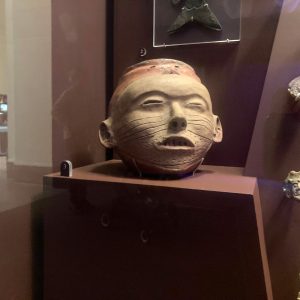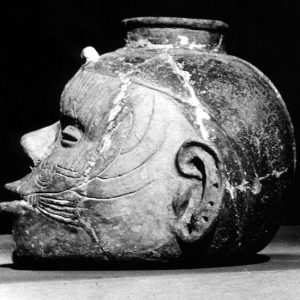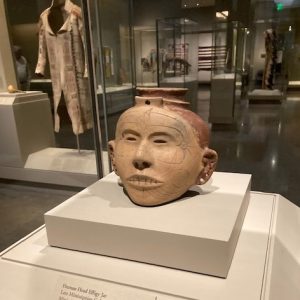calsfoundation@cals.org
Head Pots
Head pots are a very rare and unique form of pre-historic Native American pottery found almost exclusively in northeast Arkansas and the adjacent bootheel region of Missouri. They are distinguished from other native North American pottery in that the entire vessel is molded into the general shape of a human head, as opposed to facial features such as eyes, nose, and mouth simply being applied to the surface of a bottle or jar form. Artistically, head pots vary from crude to remarkably lifelike representations. Most are somewhat smaller than the head of a normal adult, averaging about five to six inches in height. Head pots are associated with the Late Mississippian Period to the time of European contact, dating about 1400 to 1700.
Suggesting a representation of a person in death, the teeth often are fashioned as if the facial tissues have dried and retracted, exposing the teeth. The eyes are usually closed. On a few head pots, the eyes are open, and the overall appearance of the face on the vessel is very lifelike. Pierced ears are common, often with three to six perforations along the margins of each ear. Incised lines on the faces of a number of head pots form various designs that suggest tattooing or scarification. Because similar designs appear on different faces, they probably were not individual decorations but rather standardized symbols associated with ceremonies. This is almost certainly the case with the incised “weeping eye” motif that appears on several head pots. Distinctive hair styles and perhaps headgear are shown on some vessels. Portions of many head pots are decorated with red paint; white paint was also used, usually on the face. If the eyes are open, a black stain was often put on them. The opening of the vessel is always on the top of the head. The bottom of the vessel may be flat, gently rounded, or even have an elevated base which can simulate the human neck.
The first reported head pot was excavated in 1880 at an archaeological site in Cross County by members of an expedition sponsored by Harvard University’s Peabody Museum. As of 2009, only 138 head pots have been identified, ninety of which have been found in Arkansas. These specimens vary from completely intact vessels to extremely fragmentary ones. They have been found almost exclusively in northeast Arkansas and in the southern portion of Pemiscot County, Missouri. The sites where they were found are mostly along the Mississippi, St. Francis, and Little rivers and Pemiscot Bayou.
These areas correspond to two political groups that were described by chroniclers of the Hernando de Soto expedition who entered northeast Arkansas in 1541. The Casqui lived along the St. Francis River region, while the more dominant Pacaha lived along the Mississippi River. Their villages were gone when French explorers Marquette and Joliet came down the Mississippi River in 1673. These Native Americans most likely succumbed to the introduction of numerous devastating European diseases, such as smallpox, measles and influenza. The survivors probably migrated away from northeast Arkansas to join with other Indian groups living elsewhere.
The actual purpose or function of head pots within the societies that fashioned them is unknown. Because most of them give an appearance of death, they may be ceramic representations of the severed heads of enemies, also called trophy heads. Alternatively, they may portray the faces of deceased revered ancestors or even a person in a trance-like state of meditation. The minority of head pots with open eyes and a more lifelike appearance probably represents individuals of political and/or religious importance. That they portray mythological deities has also been proposed.
A number of head pots are strikingly similar to each other, as if the potter were making more than one representation of the same person. Most of these were found on the same or nearby village sites. However, there are a few examples of these related head pots being found at further distances, indicating patterns of trade or political influence. For example, very similar head pots have been found at the Campbell Site in Southern Pemiscot County, Missouri, and also at the Rose Mound in Cross County and Big Eddy in St. Francis County, Arkansas. Further, based on the small number of vessels and the similarities among many of them, it seems likely that head pots were produced by only a few artists for special occasions.
Examples can be seen at the Hampson Archeological Museum State Park in Wilson (Mississippi County), the Parkin Archeological State Park in Parkin (Cross County) and in the University of Arkansas Museum open collection area, which is housed at the Arkansas Archeological Survey in Fayetteville (Washington County).
For additional information:
Cherry, James F. The Headpots of Northeast Arkansas and Southern Pemiscot County, Missouri. Fayetteville: University of Arkansas Press, 2009.
Hathcock, Roy. Ancient Indian Pottery of the Mississippi River Valley. Camden, AR: Hurley Press, Inc., 1976.
Mills, Lawrence. “Mississippian Head Vases of Arkansas and Missouri.” The Missouri Archeologist 30 (1968): 1–83.
O’Brien, Michael J. Cat Monsters and Headpots. Columbia: University of Missouri Press, 1994.
James Cherry
Fayetteville, Arkansas
 Ceramic Head
Ceramic Head  Head Pot
Head Pot  Head Pot Display
Head Pot Display 



Comments
No comments on this entry yet.